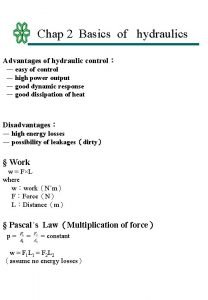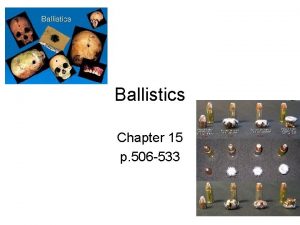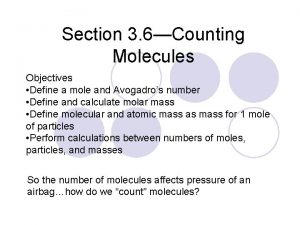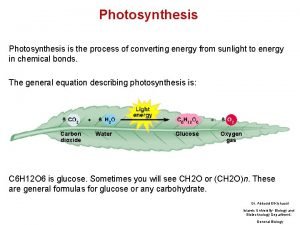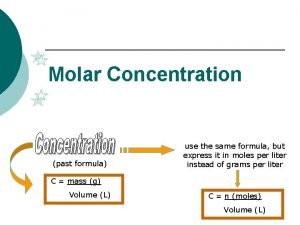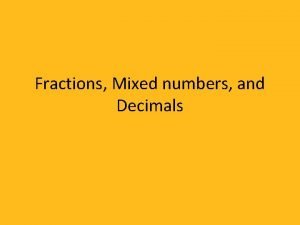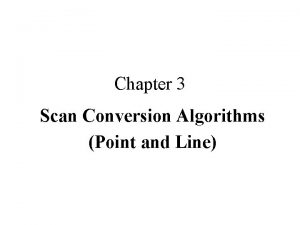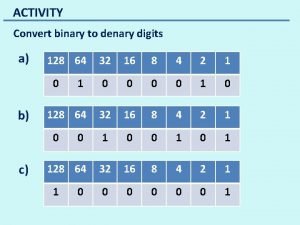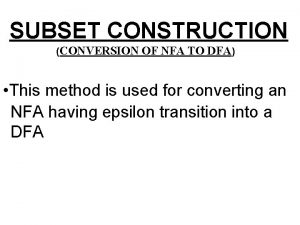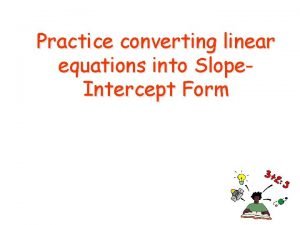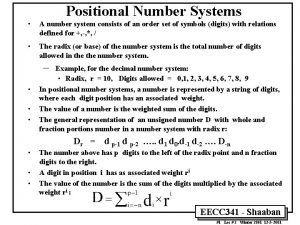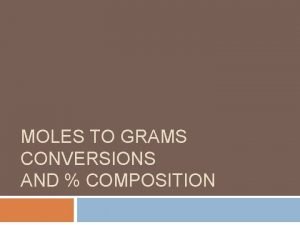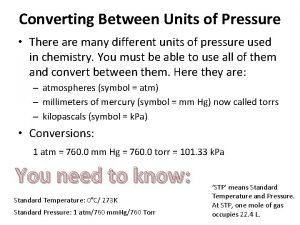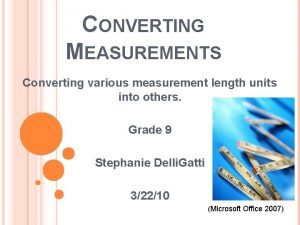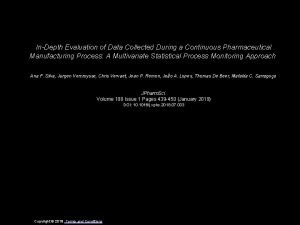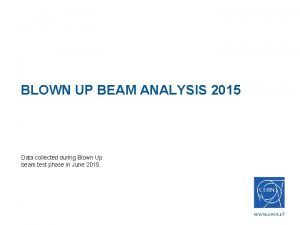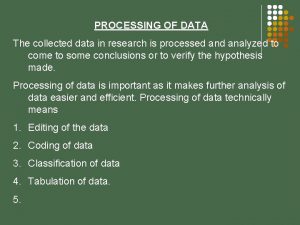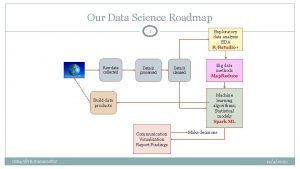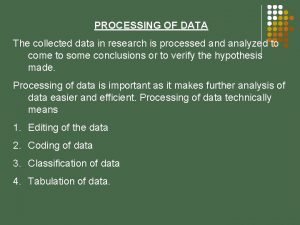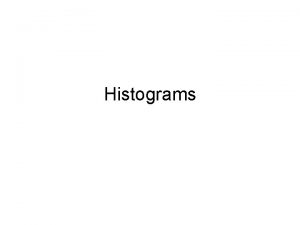Converting Data Collected During CHAPS for Use in












![parse. CHAPS Outline Create Namelist Files for each Day [Clear & Cloudy Segments] Create parse. CHAPS Outline Create Namelist Files for each Day [Clear & Cloudy Segments] Create](https://slidetodoc.com/presentation_image/ba2411bdbcab8e3f9d222a1a29df74f9/image-13.jpg)

















- Slides: 30

Converting Data Collected During CHAPS for Use in the PNNL Aerosol Modeling Testbed Brody Bourque GCEP SURE Summer Intern Larry Berg, William Gustafson Jr. , Jeremy Rishel Pacific Northwest National Laboratory

Overview Define aerosols Why study? ? Effects on climate Background on CHAPS field campaign Why focus on shallow cumuli Instruments on board aircrafts Gulfstream (G-1) NASA King Air Introduction to Aerosol Modeling Testbed (AMT) parse. CHAPS program outline

Aerosols Aerosol: a collection of particles suspended in a parcel of air (ranging from nm - 30 um) Why Study Aerosols? ? ?

Intergovernmental Panel on Climate Change (IPCC) - scientific body that provides the world with a clear view of the current state of climate change Cooling Effect High Level of Uncertainty http: //www. ipcc. ch/organization. htm

Aerosol Effects On Climate Direct effect Changes in the amount of radiation at the surface due to aerosols Semi-direct effect Changes the stability of the atmosphere (frequency of clouds) *Indirect effect Changes the amount of cloud droplets *Important for radiation and precipitation

NASA King Air Background on CHAPS Cumulus Humilis Aerosol Processing Study (CHAPS) Date: June 2007 Location: A series of flights (G-1 = 12 & King Air = 20) over the ACRF Southern Great Plains site and § Moderately sized city that is representative Battelle of a large. G-1 number Gulfstream of cities around the United States Abstract: Use in situ measurements to characterize and contrast aerosol optical & chemical properties below the shallow cumuli cloud layer (bc), in the shallow cumuli cloud layer (ic), and above the shallow cumuli cloud layer (ac) Berg et al. Oklahoma City, OK

CHAPS Experimental Goals Primary Objective: To improve the understanding of effects of radiation from aerosols on climate CHAPS Study Encompasses: Clear Sky Observations *Effects of: Aerosols on Shallow Cumuli on Aerosols *Particularly how Shallow Cumuli effect the chemical and optical properties of aerosols

Why Focus On Shallow Cumuli? ? ? Shallow clouds play an important role in energy balance Increases amount of shortwave radiation that is reflected back into space (shortwave albedo) Not much effect on longwave radiation Poorly represented in numerical models

Instruments Aboard The Gulfstream (G-1) Two Inlets: *Counter-Flow Virtual Impactor (CVI) Isokinetic Inlet (>10 um) Each inlet has virtually the same instrumentation *Aerosol Mass Spectrometer (AMS) Size Distributions: SMPS (0. 02 um - 0. 44 um) FIMS (0. 03 um - 0. 13 um) (<2 um) PCASP (0. 10 um - 3. 00 um) CAS (0. 627 um - 60. 0 um) CIP (25 um - 1500 um) * ”One of few studies that have had AMS sampling downstream of CVI inlet on an aircraft…allows for the examination of chemical composition of nucleated aerosols within the cumuli”

Instruments Aboard The NASA King Air NASA High Spectral Resolution LIDAR (HSRL) Measures Profiles Between the King Air and the Surface of Aerosol: Backscatter Extinction Depolarization

High Spectral Resolution LIDAR (HSRL)

Aerosol Modeling Testbed (AMT) What is it? ? ? A computational framework that streamlines the process of testing and evaluating refined aerosol process modules over a wide range of spatial (0. 1 - 100 km) and temporal (minutes - season) scales Composed of the chemistry version of the Weather Research and Forecasting Model (WRF - Chem) and various statistical and graphical programs, called the Analysis Toolkit, that allow investigators to systematically evaluate model performance
![parse CHAPS Outline Create Namelist Files for each Day Clear Cloudy Segments Create parse. CHAPS Outline Create Namelist Files for each Day [Clear & Cloudy Segments] Create](https://slidetodoc.com/presentation_image/ba2411bdbcab8e3f9d222a1a29df74f9/image-13.jpg)
parse. CHAPS Outline Create Namelist Files for each Day [Clear & Cloudy Segments] Create Output Files for all Variables with a Location File Use MILAGRO Convention All Output Files must include the Location Files MILAGRO Naming Convention: Use MILAGRO Convention variable_obs. txt Location File to include only in header: Year Month Day Time UTC Latitude Longitude Altitude tflag MILAGRO Naming Convention: aircraft_yymmdd_loc. txt

G-1 Data

King Air Data

Creating Namelist Files Very First Step Purpose: tells the program § how many files to read § which files to read Created for each Day and for both Clear & Cloudy Flight Segments

Creating Output Files for all Variables Transect Flag (tflag): iso_green_eff_s_obs. txt § Used to partition data based on a set parameter iso_green_smooth_abs_obs. txt g 1_070611_clear_loc. txt cvi_green_inverted_tot_s_obs. txt air_speed_obs. txt cvi_green_inverted_back_s_obs. txt altitude_obs. txt cvi_green_ssa_obs. txt ams_on_cvi_obs. txt cvi_green_tot_s_obs. txt cas_tot_a_obs. txt cvi_lwc_obs. txt • Above Cloud (ac) = 3 cas_tot_a_cloud_obs. txt cvi_neph_rh_obs. txt • In Cloud (ic) = 2 cas_tot_n_obs. txt cvi_neph_ti_obs. txt cas_tot_n_cloud_obs. txt • Below Cloud cvi_red_back_s_obs. txt (bc) = 1 cas_tot_v_obs. txt cvi_red_abs_obs. txt cas_tot_v_cloud_obs. txt cvi_red_inverted_tot_s_obs. txt ccn_obs. txt cvi_red_inverted_back_s_obs. txt cip_tot_a_obs. txt cvi_red_ssa_obs. txt cip_tot_n_obs. txt cvi_red_tot_s_obs. txt cip_tot_v_obs. txt density_obs. txt cl_obs. txt dew_point_temperature_obs. txt co_obs. txt fims_tot_n_obs. txt cvi_blue_abs_obs. txt flag_cloud_obs. txt cvi_blue_back_s_obs. txt flag_plume_obs. txt cvi_blue_eff_s_obs. txt ger_lwc_obs. txt cvi_blue_inverted_back_s_obs. txt heading_obs. txt cvi_blue_inverted_tot_s_obs. txt iso_blue_back_s_obs. txt cvi_blue_red_angstrom_obs. txt iso_blue_eff_s_obs. txt cvi_blue_ssa_obs. txt iso_blue_red_angstrom_obs. txt cvi_blue_tot_s_obs. txt iso_blue_smooth_abs_obs. txt cvi_cn_obs. txt iso_blue_ssa_obs. txt cvi_enrich_fac_obs. txt iso_blue_tot_s_obs. txt cvi_flag_qc_obs. txt iso_cn_obs. txt cvi_green_abs_obs. txt iso_flag_qc_obs. txt cvi_green_back_s_obs. txt iso_green_back_s_obs. txt § Parameters: a c o L n it o F li e iso_green_ssa_obs. txt iso_green_tot_s_obs. txt iso_neph_rh_obs. txt iso_neph_ti_obs. txt iso_red_back_s_obs. txt iso_red_eff_s_obs. txt iso_red_smooth_abs_obs. txt iso_red_ssa_obs. txt iso_red_tot_s_obs. txt lapa_abs_obs. txt lapa_s_obs. txt lat_obs. txt long_obs. txt nh 4_obs. txt no 3_obs. txt org_obs. txt ozone_obs. txt papa_abs_obs. txt papa_s_obs. txt pcasp_int_obs. txt pcasp_tot_a_obs. txt pcasp_tot_n_obs. txt pcasp_tot_v_obs. txt potential_temperature_obs. txt pressure_obs. txt ptrms_a_pinene_frag_obs. txt ptrms_a_pinene_parent_obs. txt ptrms_acetaldehyde_obs. txt ptrms_acetonitile_obs. txt ptrms_benzene_obs. txt ptrms_isoprene_obs. txt ptrms_mek_macr_obs. txt ptrms_methanol_obs. txt ptrms_mvk_obs. txt ptrms_tmb_obs. txt ptrms_toluene_obs. txt ptrms_xylene_obs. txt sat_temperature_obs. txt so 2_obs. txt so 4_obs. txt temperature_obs. txt w_prime_obs. txt wind_direction_obs. txt wind_speed_obs. txt

Problem With Particle Size Distribution PROBLEM: Because WRF Bin size ranges and Instrument Channel size ranges are different, calculations for output files will be wrong SOLUTION: Write a separate program [for each Instrument Channel] that will map Instrument Channels to correct WRF Bins [for both 8 Bin WRF & 4 Bin WRF] based on size ranges

Instrument Channel Size Ranges 0. 018 - 0. 4 um

Mapping File wrf_bin_ version wrf_bin_ number wrf_diameter_ min wrf_diameter_ max 8 1 0. 0390625 0. 078125 8 2 0. 078125 0. 15625 2 7 8 3 0. 15625 0. 3125 8 15 0. 625 16 18 1. 25 19 21 2 6 PCASP Instrument 8 4 0. 3125 Channels Mapped to 8 5 0. 625 8 Bin WRF Bins pcasp_ min pcasp_ max cas_ min cas_ max smps_ min smps_ max 9 3 6 10 14 7 10 3 10 15 8 Bin WRF Bin Size Ranges 19[um] 18 21 6 1. 25 2. 5 22 28 7 9 8 7 2. 5 5 29 30 10 11 8 8 5 10 12 13 4 1 0. 0390625 0. 15625 2 7 0. 625 8 18 2. 5 19 28 4 Bin WRF 15 Bin 21 2 9 Size Ranges [um] 10 29 30 10 6 13 fims_ max 6 8 PCASP Instrument 4 2 0. 15625 Channels Mapped to 4 3 0. 625 44 Bin WRF Bins 2. 5 4 fims_ min 14

Create Output Files For Instrument Channels & WRF Bins Using MILAGRO Convention Total Number (n): Total Area (a): The sum of all the particles within Instrument Channels The area of all the particles the specifiedentire channel pcasp_ch_1_obs. txt within the specified channel pcasp_ch_2_obs. txt pcasp_ch_3_obs. txt pcasp_ch_4_obs. txt n = value pcasp_ch_5_obs. txt a = value 1 ( * r ^2) + … 4 Bin WRF Bins pcasp_ch_6_obs. txt pcasp_ch_7_obs. txt pcasp_4 binwrf_bin 1 area_ins_obs. txt r = midpoint of channel size range pcasp_ch_8_obs. txt pcasp_4 binwrf_bin 1 number_obs. txt pcasp_ch_9_obs. txt pcasp_4 binwrf_bin 1 volume_ins_obs. txt pcasp_ch_10_obs. txt pcasp_4 binwrf_bin 2 area_ins_obs. txt pcasp_ch_11_obs. txt pcasp_4 binwrf_bin 2 number_obs. txt pcasp_ch_12_obs. txt pcasp_4 binwrf_bin 2 volume_ins_obs. txt pcasp_ch_13_obs. txt pcasp_4 binwrf_bin 3 area_ins_obs. txt pcasp_ch_14_obs. txt pcasp_4 binwrf_bin 3 number_obs. txt pcasp_ch_15_obs. txt pcasp_4 binwrf_bin 3 volume_ins_obs. txt pcasp_ch_16_obs. txt pcasp_4 binwrf_bin 4 area_ins_obs. txt pcasp_ch_17_obs. txt pcasp_4 binwrf_bin 4 number_obs. txt pcasp_ch_18_obs. txt pcasp_4 binwrf_bin 4 volume_ins_obs. txt pcasp_ch_19_obs. txt pcasp_ch_20_obs. txt pcasp_ch_21_obs. txt pcasp_ch_22_obs. txt pcasp_ch_23_obs. txt pcasp_ch_24_obs. txt pcasp_ch_25_obs. txt pcasp_ch_26_obs. txt pcasp_ch_27_obs. txt pcasp_ch_28_obs. txt pcasp_ch_29_obs. txt pcasp_ch_30_obs. txt Total Volume (v): 8 Bin WRF The entire volume of Bins all the particles within the specified pcasp_8 binwrf_bin 1 area_ins_obs. txt channel pcasp_8 binwrf_bin 1 number_obs. txt pcasp_8 binwrf_bin 1 volume_ins_obs. txt pcasp_8 binwrf_bin 2 area_ins_obs. txt pcasp_8 binwrf_bin 2 number_obs. txt pcasp_8 binwrf_bin 2 volume_ins_obs. txt v = value 1 * (4/3) * ( * r ^3) + … pcasp_8 binwrf_bin 3 area_ins_obs. txt pcasp_8 binwrf_bin 3 number_obs. txt r = midpoint of channel size range pcasp_8 binwrf_bin 3 volume_ins_obs. txt pcasp_8 binwrf_bin 4 area_ins_obs. txt pcasp_8 binwrf_bin 4 number_obs. txt pcasp_8 binwrf_bin 4 volume_ins_obs. txt pcasp_8 binwrf_bin 5 area_ins_obs. txt pcasp_8 binwrf_bin 5 number_obs. txt pcasp_8 binwrf_bin 5 volume_ins_obs. txt pcasp_8 binwrf_bin 6 area_ins_obs. txt pcasp_8 binwrf_bin 6 number_obs. txt pcasp_8 binwrf_bin 6 volume_ins_obs. txt pcasp_8 binwrf_bin 7 area_ins_obs. txt pcasp_8 binwrf_bin 7 number_obs. txt pcasp_8 binwrf_bin 7 volume_ins_obs. txt pcasp_8 binwrf_bin 8 area_ins_obs. txt pcasp_8 binwrf_bin 8 number_obs. txt pcasp_8 binwrf_bin 8 volume_ins_obs. txt e ee m e l m l e i m a i l a i F S San F F S n n o o i i o t i t t a a a c a t o o t a o a L L L D Da D e

Analysis Toolkit Structure CHAPS king_air

Directory Tree Setup (G-1) Directory Tree Setup (King Air)

Time Series Plots From Toolkit Temperature Wind Speed Pressure Water Vapor Mixing Ratio

Histograms For King Air Data Aerosol Optical Depth Cloud Top Height

Questions? !

A Special Thanks To… Anne Case Hanks, Boniface Mills University of Louisiana at Monroe Jeff Gaffney, Milton Constantin Global Change Education Program Larry Berg, Carl Berkowitz, Elaine Chapman, Jim Droppo, Bill Gustafson, Laura Riihimaki, Jeremy Rishel, William Shaw, Tricia St Hilaire Pacific Northwest National Laboratory

Transect Flag (tflag) King Air Output Files § Parameters: • Flight Leg 2 (L 2) = 2 • Flight Leg 1 (L 1) = 1 king_air_070611_loc. txt aerosol_optical_depth_obs. txt altitude_obs. txt cloud_top_height_obs. txt lat_obs. txt long_obs. txt planetary_boundary_layer_1_obs. txt planetary_boundary_layer_2_obs. txt planetary_boundary_layer_3_obs. txt time_obs. txt L c o t a n io le i F

Analysis Toolkit Structure (in depth)

King Air Statistics H i s t o g r a m rd Aerosol a d s n a St tistic Optical Sta Depth Data Distrib ution H i s t o g r a m rd Cloud Top a d s n Sta tistic a Height t S Data Distrib ution
 Chaps advantages and disadvantages
Chaps advantages and disadvantages Quantitative and qualitative examples
Quantitative and qualitative examples Scientists recently discovered that rocks collected
Scientists recently discovered that rocks collected How are ballistics collected
How are ballistics collected Skim scan skip
Skim scan skip Personal possessive demonstrative pronouns
Personal possessive demonstrative pronouns Molecules to moles
Molecules to moles Ellipse scan conversion algorithm
Ellipse scan conversion algorithm Photosynthesis is the process of converting
Photosynthesis is the process of converting Molar mass to grams
Molar mass to grams How to convert grams to moles
How to convert grams to moles Recurring decimal examples
Recurring decimal examples Decimals to mixed numbers
Decimals to mixed numbers It is a disease that prevents the body from converting
It is a disease that prevents the body from converting Converting prius to plug in
Converting prius to plug in Customary units of capacity
Customary units of capacity Customary and metric units
Customary and metric units What is the basis of scan conversion of circle
What is the basis of scan conversion of circle Converting grams to moles
Converting grams to moles Scan conversation
Scan conversation Azimuth to bearing
Azimuth to bearing 64+32+8+4+2+1
64+32+8+4+2+1 Convert nfa to dfa
Convert nfa to dfa Converting linear equations
Converting linear equations Positional numbering system
Positional numbering system How many moles in a gram
How many moles in a gram Converting amino acids to glucose
Converting amino acids to glucose Converting between units of pressure
Converting between units of pressure Point-slope form definition geometry
Point-slope form definition geometry Peak voltage and rms voltage
Peak voltage and rms voltage King henry metric system
King henry metric system
